Studies on the Source and Phase Characteristics of Oil and Gas: Evidence from Hydrocarbon Geochemistry in the Pingbei Area of Xihu Sag, the East China Sea Shelf Basin, China
Abstract
:1. Introduction
2. Geological Background
3. Sampling and Methodology
3.1. Sampling Locations and Data Collection
3.2. Experimental Methods
4. Results
4.1. Chemical Compositions of the Oil and Gas
4.2. Geochemical Characteristics of Source Rocks
5. Discussion
5.1. Origin of Oil and Gas
5.1.1. Genesis of Oil and Gas
5.1.2. Maturity of Oil and Gas
5.1.3. Oil and Gas Source Correlations
5.2. Compositional Alteration and Migration of Hydrocarbons
5.2.1. Mechanisms of Altered Hydrocarbon Composition
5.2.2. Migration Characteristics of Hydrocarbons
6. Conclusions
Author Contributions
Funding
Data Availability Statement
Acknowledgments
Conflicts of Interest
References
- Yin, S.; Ye, J.; Lei, C.; Shan, C.; Tian, Y.; Liu, F. Geochemical characteristics of Pinghu crude oils in Pingbei area of Xihu Sag. Xinjiang Petrol. Geol. 2014, 35, 542–546. [Google Scholar]
- Zhou, X.; Gao, S.; Gao, W.; Li, N. Formation and distribution of marine-continental transitional lithologic reservoirs in Pingbei slope belt, Xihu sag, East China Sea Shelf Basin. China Pet. Explor. 2019, 24, 153–164. [Google Scholar]
- Su, A.; Chen, H.; Wang, C.; Li, P.; Zhang, H.; Xiong, W.; Lei, M. Genesis and maturity identification of oil and gas in the Xihu Sag, East China Sea Basin. Pet. Explor. Dev. 2013, 40, 521–527. [Google Scholar] [CrossRef]
- Zhang, K.; Tang, Y.; Hu, S.; Wang, H.; Gao, M. Detection of diamantane hydrocarbons in the oil of Pinghu slope belt and its geochemical significance. J. Oil Gas Technol. 2014, 36, 30–34. [Google Scholar]
- Xu, T.; Hou, D.; Cao, B. Study of precursors for condensates and light oils in Xihu Sag of East China Sea Basin. Geochimica 2015, 44, 289–300. [Google Scholar]
- Cao, Q.; Song, Z.; Zhou, X.; Liang, S.; Wang, L. Geochemical characteristics and source of crude oil in Xihu sag, East China Sea Shelf Basin. Pet. Geol. Exp. 2019, 41, 251–259. [Google Scholar]
- Su, A.; Chen, H.; Wang, C.; Li, P.; Ma, L.; Liu, H. Source of natural gas in Xihu Sag of the East China Sea Basin. Geol. Sci. Technol. Inf. 2014, 33, 157–169. [Google Scholar]
- Liu, B.; Gao, S.; Mohammadian, E.; Hadavimoghaddam, F.; Tian, S.; Xu, Y.; Pan, Z. Comprehensive Outlook into Critical Roles of Pressure, Volume, and Temperature (PVT) and Phase Behavior on the Exploration and Development of Shale Oil. Energy Fuels 2022, 36, 14534–14553. [Google Scholar] [CrossRef]
- Kuske, S.; Horsfield, B.; Jweda, J.; Michael, G.E.; Song, Y. Geochemical factors controlling the phase behavior of Eagle Ford Shale petroleum fluids. AAPG Bull. 2019, 103, 835–870. [Google Scholar] [CrossRef]
- Liu, J.; Cao, B.; Xu, Z.; Qin, L.; Xu, F.; Tang, J. Sedimentary facies and the characteristics of tight sandstone reservoirs of Huagang Formation in Xihu Sag, East China Sea Basin. J. Chengdu Univ. Technol. 2012, 39, 130–136. [Google Scholar]
- Jia, J.; Xu, X.; Sun, B. Oil/gas geochemical character in the Xihu Trough of the East China Sea. Offshore Oil 2000, 2, 1–7. [Google Scholar]
- Fu, N.; Li, Y.; Chen, G.; Chen, M.; Gao, W.; Zhang, H. Pooling mechanisms of “evaporating fractionation” of oil and gas in Xihu Sag, East China Sea. Pet. Explor. Dev. 2003, 30, 39–42. [Google Scholar]
- Zhang, G.; Miao, S.; Chen, Y.; Zhao, Z.; Li, Y.; Zhang, H.; Yang, H.; Yang, S. Distribution of gas enrichment regions controlled by source rocks and geothermal heat in China Offshore Basin. Nat. Gas Ind. 2013, 33, 1–17. [Google Scholar]
- Wang, Y.; Chen, J.; Pang, X. Hydrocarbon generation and expulsion of tertiary coaly source rocks and hydrocarbon accumulation in the Xihu Sag of the East China Sea Shelf Basin, China. J. Asian Earth Sci. 2022, 22, 155–170. [Google Scholar]
- Dai, J.; Gong, D.; Ni, Y. Stable carbon isotopes of coal-derived gases sourced from the Mesozoic coal measures in China. Org. Geochem. 2014, 74, 123–142. [Google Scholar] [CrossRef]
- Liu, K.; Chen, J.; Zhu, X. The geochemical characteristics, genetic types and sources analysis of natural gas in Pingbei area, Xihu Sag. China Offshore Oil gas 2019, 31, 42–52. [Google Scholar]
- Tong, Z.; He, Q.; He, S.; Yang, S.; Xiong, B.; Hao, J. Geothermal field and its effect on source rock in the Xihu Sag, the East China Sea Basin. Pet. Geol. Exp. 2009, 31, 466–471. [Google Scholar]
- Hu, T.; Ge, B.; Zhang, Y.; Liu, B. The development and application fingerprint parameters for hydrocarbons absorbed by source rocks and light hydrocarbons in natural gas. Pet. Geol. Exp. 1990, 12, 375–394. [Google Scholar]
- Dai, J. Identification and distinction of various alkane gases. Sci. China B 1992, 2, 185–193. [Google Scholar]
- Xu, Y.; Shen, P.; Liu, W.; Wang, W. A new genetic type of natural gas: Biogenic-thermal catalyzed gas. Sci. China B 1992, 20, 975–980. [Google Scholar]
- Mango, F. An invariance in the isoheptanes of petroleum. Science 1987, 237, 514–517. [Google Scholar] [CrossRef] [PubMed]
- Mango, F. The light hydrocarbons in petroleum: A critical review. Org. Geochem. 1997, 26, 417–440. [Google Scholar] [CrossRef]
- Wang, X.; Zhang, M.; Huang, G. Compositions and geochemical characteristics of light hydrocarbons in typical marine oils and typical coal-formed oils. Nat. Gas Geosci. 2008, 19, 18–22. [Google Scholar]
- Radke, M. Application of aromatic compounds as maturity indicators in source rocks and crude oils. Mar. Pet. Geol. 1988, 5, 224–236. [Google Scholar] [CrossRef]
- He, L.; Chen, J.; Liu, K.; Zhu, X.; Zhang, C.; Li, W.; Luo, G.; Wang, Y.; Zhao, X.; Wu, J. Geochemical characteristics and sources of natural gas in the northern Xihu Sag. Nat. Gas Ind. 2019, 39, 53–62. [Google Scholar]
- Liu, B.; Yan, D.; Fu, X.; Lü, Y.; Gong, L.; Wang, S. Investigation of geochemical characteristics of hydrocarbon gas and its implications for Late Miocene transpressional strength—A study in the Fangzheng Basin, Northeast China. Interpretation 2018, 6, 83–96. [Google Scholar] [CrossRef]
- Liu, W.; Xu, Y. A two-stage model of carbon isotopic fractionation in coal-gas. Geochimica 1999, 28, 359–366. [Google Scholar]
- Erdman, J.; Morris, D. Geochemical correlation of petroleum. AAPG Bull. 1974, 58, 2326–2337. [Google Scholar]
- Stahl, W.J. Source rock-crude oil correlation by isotopic type-curves. Geochim. Cosmochim. Acta 1978, 42, 1573–1577. [Google Scholar] [CrossRef]
- Shen, P.; Xu, Y. Study on carbon and hydrogen isotopes composition of crude oils. Acta Sedimentol. Sin. 1998, 16, 124–127. [Google Scholar]
- Thompson, K. Fractionated aromatic petroleums and the generation of gas-condensates. Org. Geochem. 1987, 11, 573–590. [Google Scholar] [CrossRef]
- Tang, Y.; Zhang, K.; Hu, S.; Wang, H.; Wen, Y. Geochemical characteristics of light hydrocarbon in Pinghu Slope of Xihu Sag. J. Oil Gas Technol. 2014, 36, 28–33. [Google Scholar]
- Huang, D.; Li, C.; Zhang, D. Geochemistry of petroleum migration during the formation of Karamay Oilfield. Sci. China 1989, 2, 199–206. [Google Scholar]
- Huang, D.; Zhao, M.; Zhang, S. Genetic Analysis of the Origin of the Lower Paleozoic Waxy Hydrocarbon from the Manjiar Oil Gas System, Tarim Basin. Acta Sedim Log. Sin. 1997, 15, 6–13. [Google Scholar]
- Huang, H.; Zhang, S.; Su, A. Geochemistry in the process of petroleum migration and accumulation. Pet. Geo. Exp. 2001, 23, 278–284. [Google Scholar]
- Larter, S.; Mills, N. phase-controlled transport fractionations in migrating. In Petroleum Migration; England, W.A., Ed.; Geological Society, London, Special Publications; Geological Society of London: London, UK, 1991; Volume 59, pp. 137–147. [Google Scholar]
- Ye, J.; Chen, H.; Chen, J.; Gu, H. Fluid history analysis in the Xihu Sag, East China Sea. Nat. Gas Ind. 2006, 26, 40–43. [Google Scholar]
- Chen, L.; Xiang, Y. Play evolution analysis of Xihu Sag. Offshore Oil 2009, 29, 1–6. [Google Scholar]
- Lu, J.; Ye, J.; Huang, S.; Wu, J. Characteristics and hydrocarbon generation-expulsion histories of source rocks of Pingbei area in Xihu Sag. Offshore Oil 2009, 29, 38–43. [Google Scholar]
- Xiong, B.; Zhang, X.; Zhang, J.; Wang, C.; Yang, H. The key factor controlling hydrocarbon accumulation in Xihu Sag. Offshore Oil. 2008, 23, 14–24. [Google Scholar]
- Su, A.; Chen, H.; Lei, C.; Chen, X.; Wang, P.; Wu, T.; Chen, J.; Chen, H. Application of PVTx simulation of fluid inclusions to estimate petroleum charge stages and restore pressure: Using Pinghu structural belt in Xihu Sag as an example. Geol. Sci. Technol. Inf. 2014, 33, 137–142. [Google Scholar]
- Su, A.; Chen, H.; Chen, X.; Ma, Y.H.; Yang, W.; Liu, H.; Li, P. Coupling relationship between diagenetic evolution and oil and gas accumulation of tight sandstone reservoir in Pinghu structural belt in Xihu Sag, Eastern Sea Basin. J. Cent. South Univ. 2015, 46, 1016–1026. [Google Scholar]
- Zhang, H.; Zhang, W. Petroleum Geology; Petroleum Industry Publishing House: Beijing, China, 1990; Volume 1, pp. 152–167. [Google Scholar]
- Dai, J.; Pei, X.; Qi, H. Natural Gas Geology in China; Petroleum Industry Publishing House: Beijing, China, 1992; Volume 1, pp. 225–284. [Google Scholar]
- Liu, B.; He, S.; Meng, L.; Fu, X.; Gong, L.; Wang, H. Sealing mechanisms in volcanic faulted reservoirs in Xujiaweizi extension, northern Songliao Basin, northeastern China. AAPG Bull. 2021, 105, 1721–1743. [Google Scholar] [CrossRef]
- Zhou, X.; Gao, W.; Zhang, J.; Zhang, N.; Tian, C. Fractures in the Pingbei area and their control on hydrocarbon accumulation in the Xihu Sag of the East China Sea. Shanghai Land Resour. 2014, 35, 54–57. [Google Scholar]

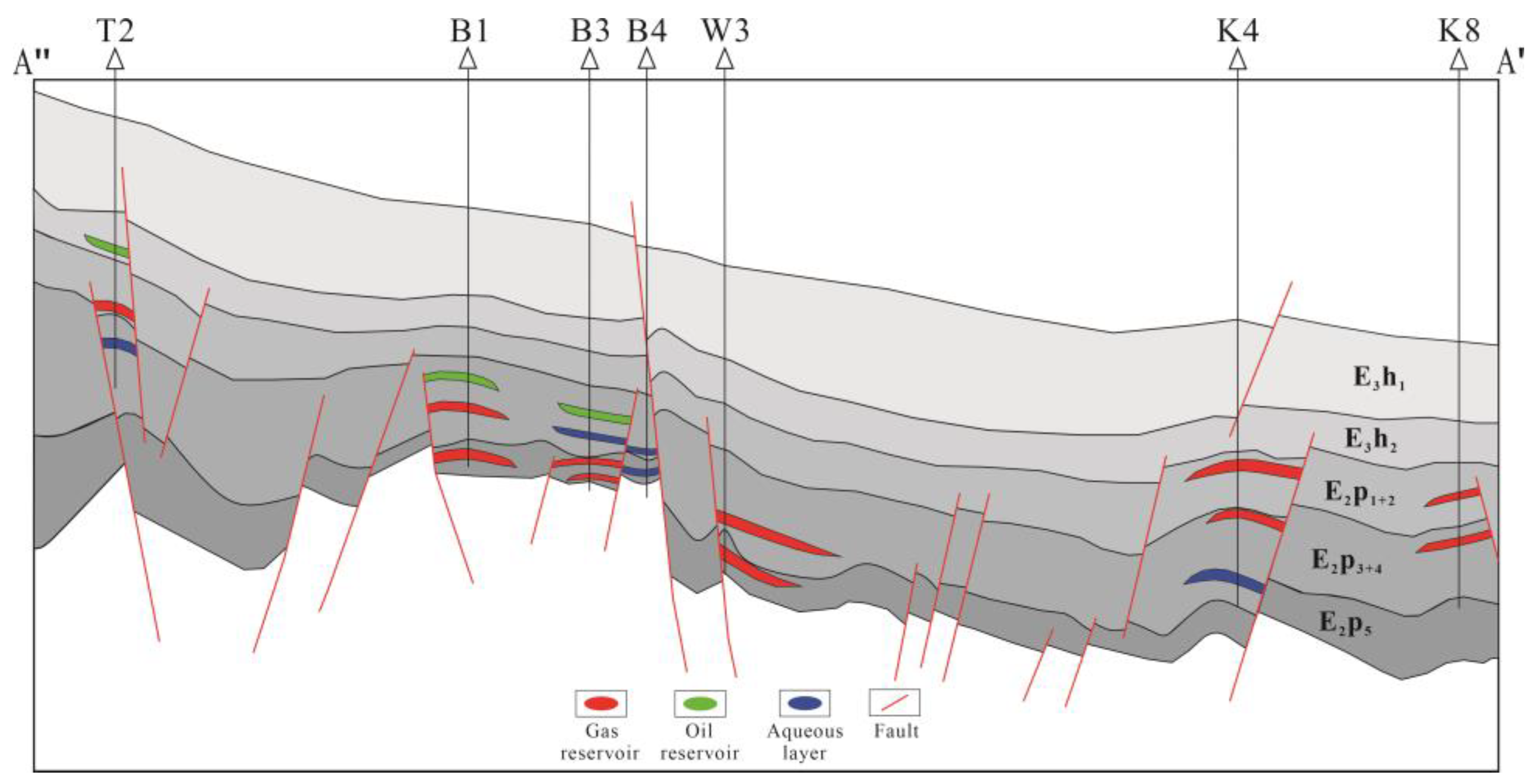
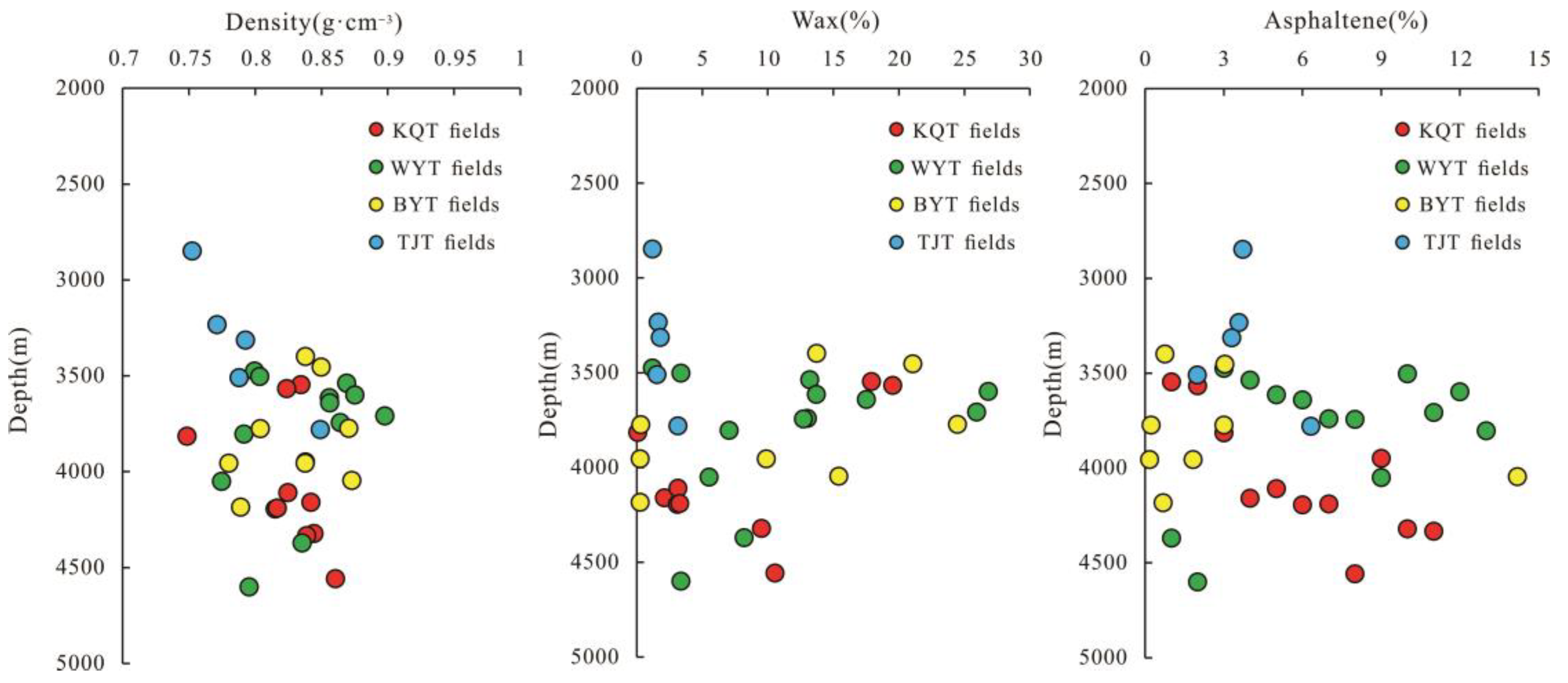

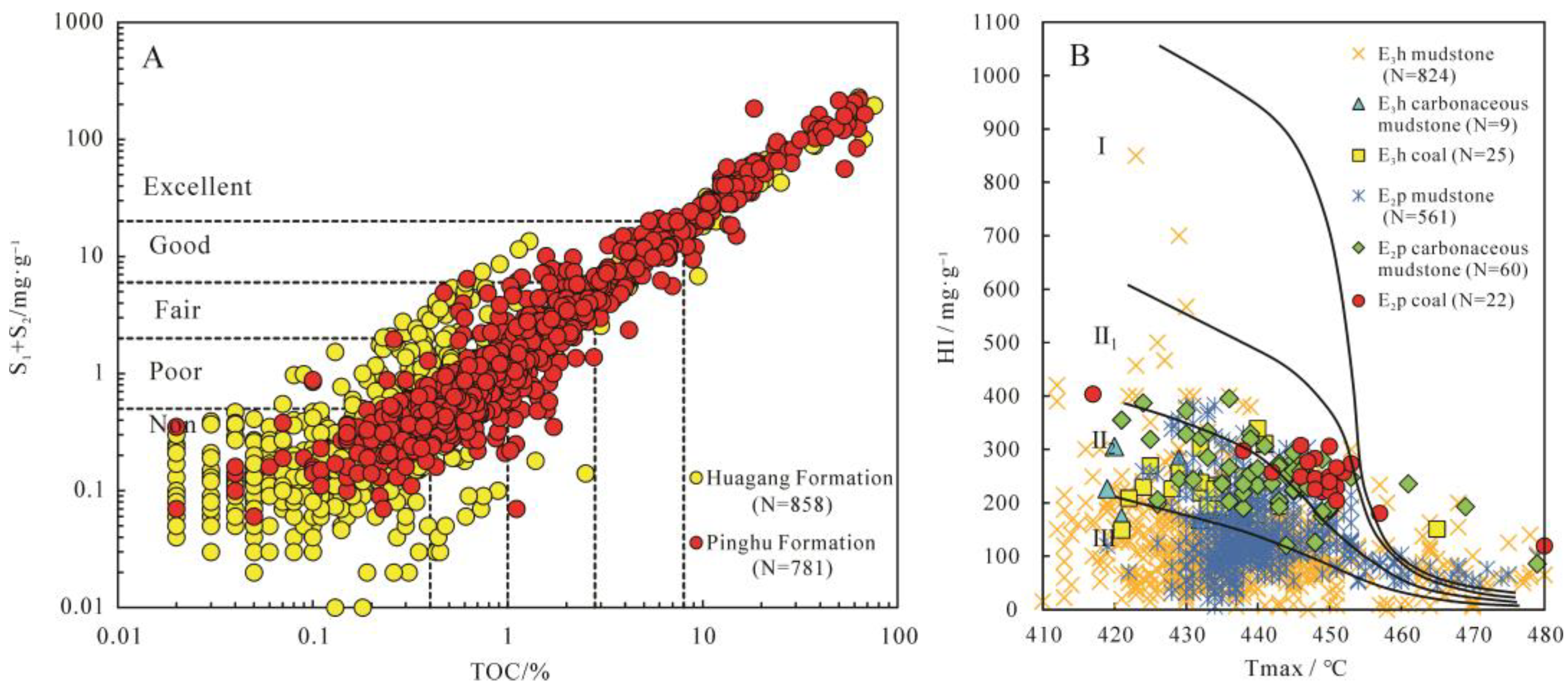
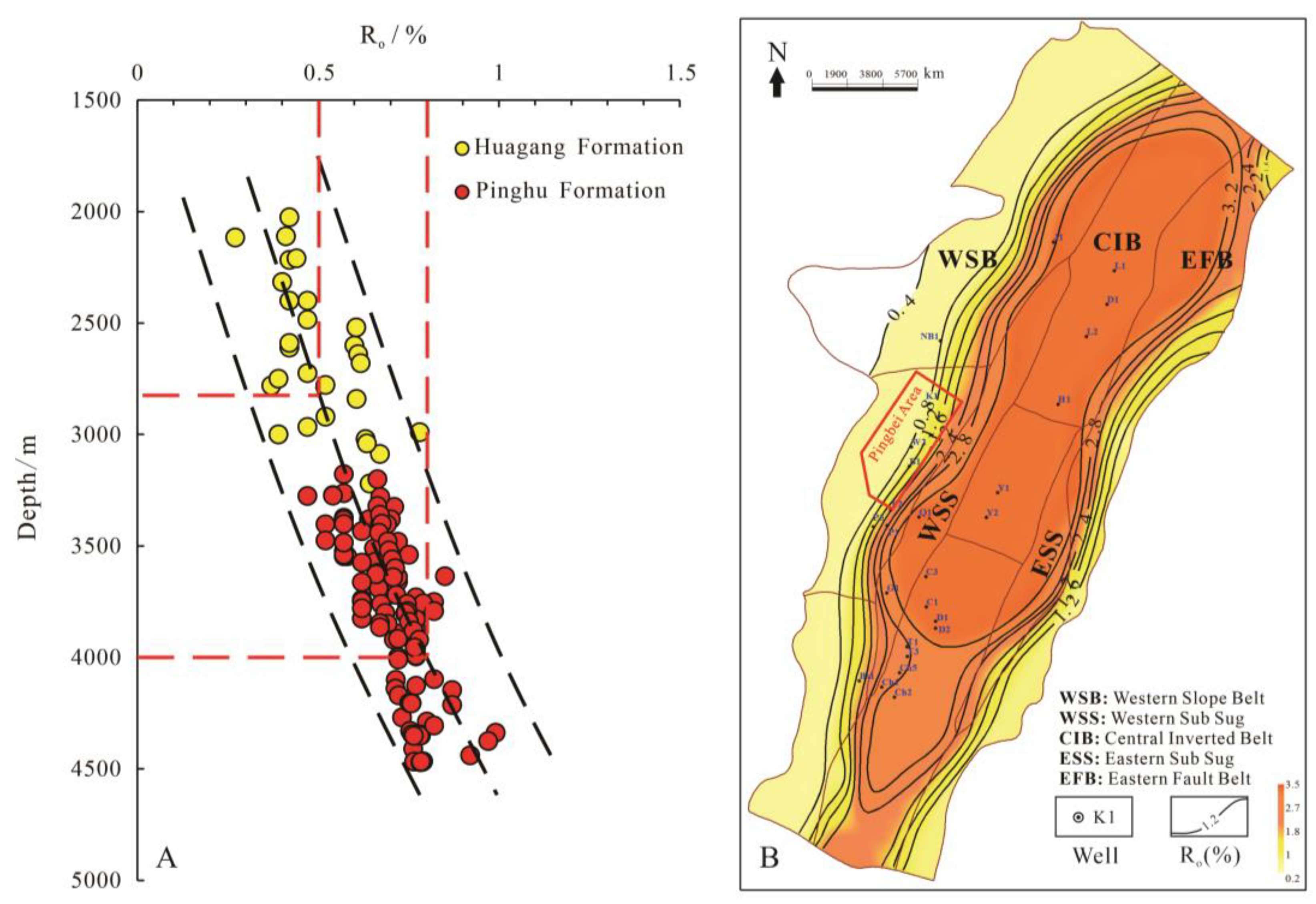


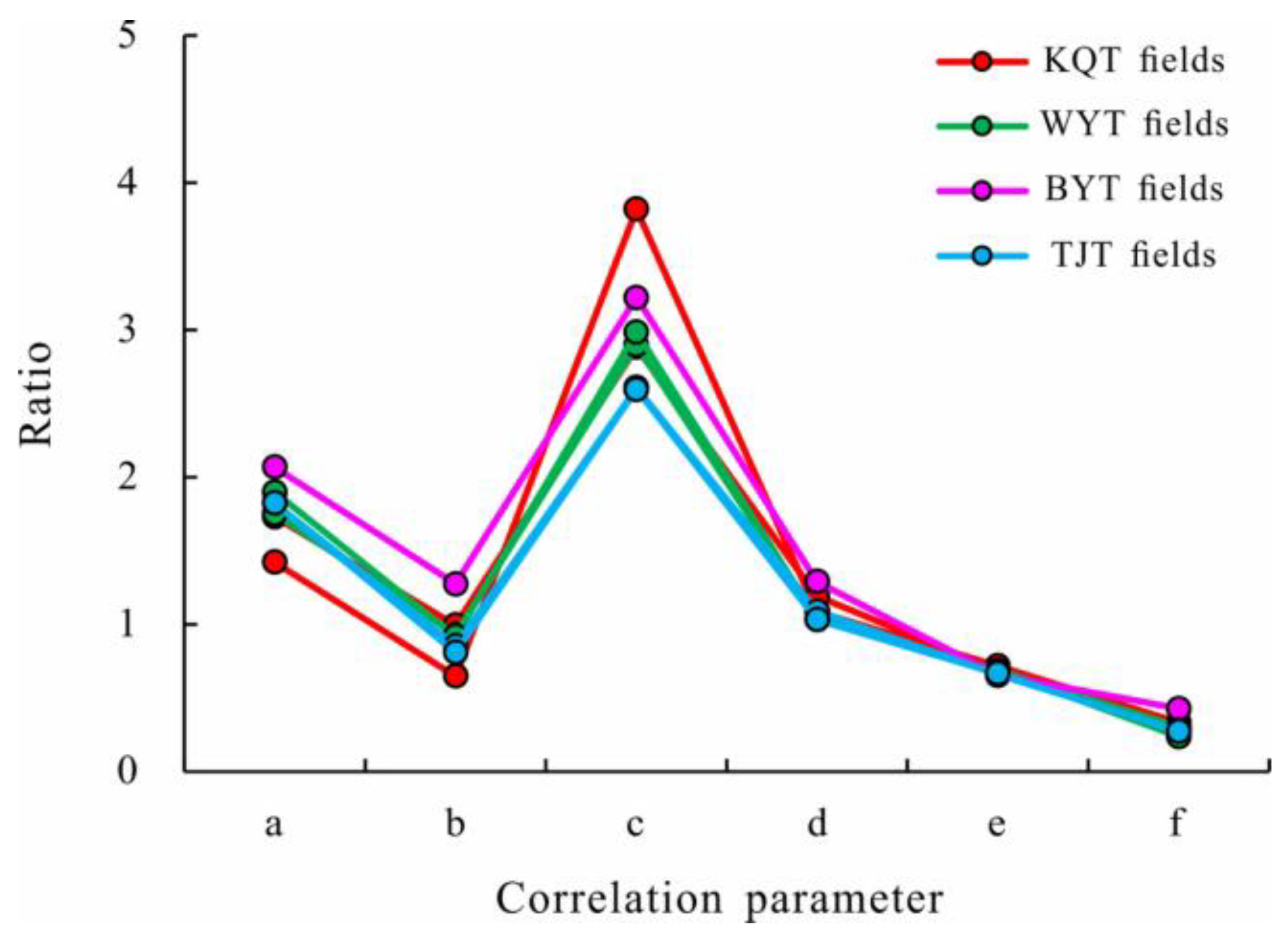
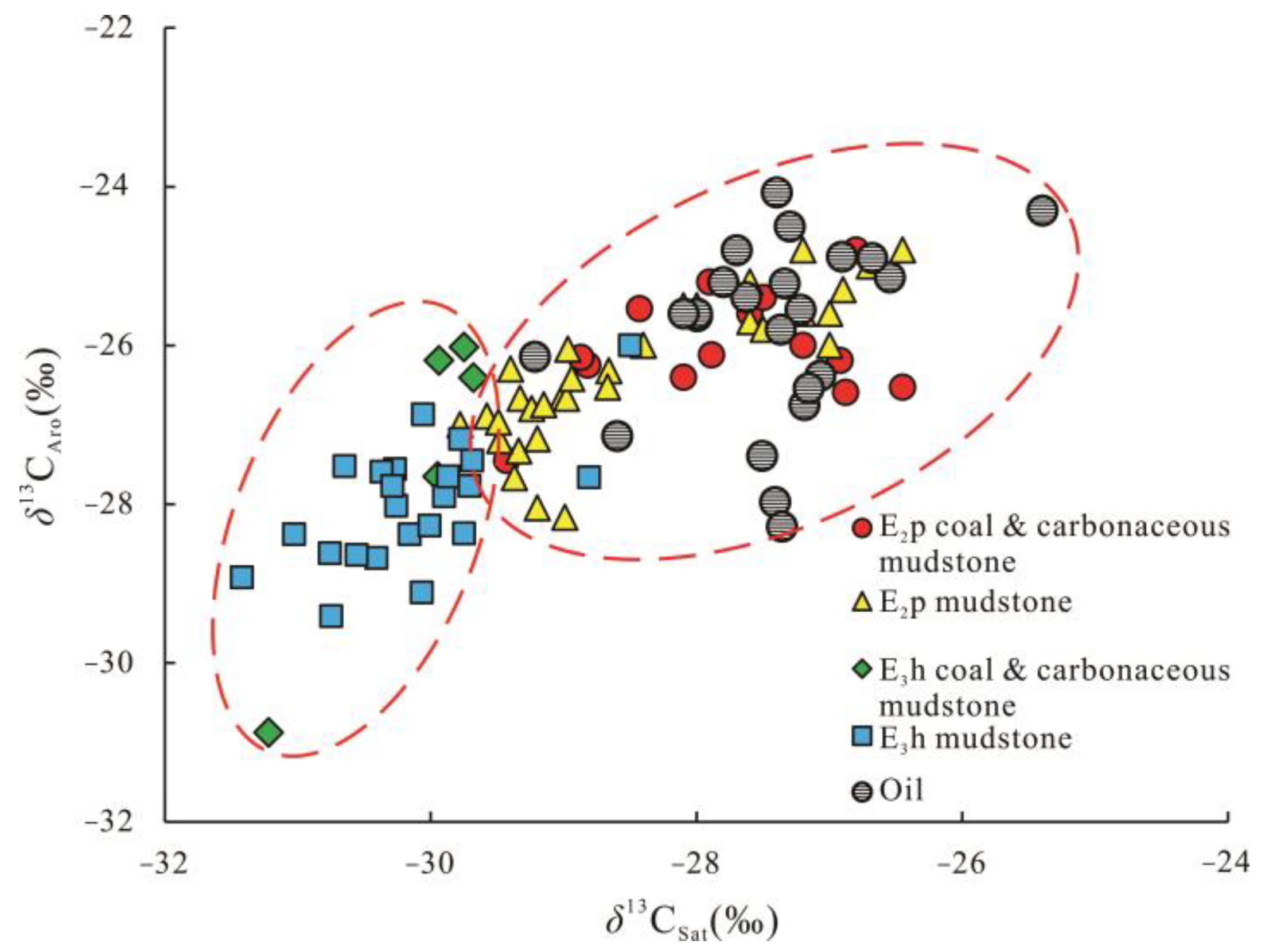
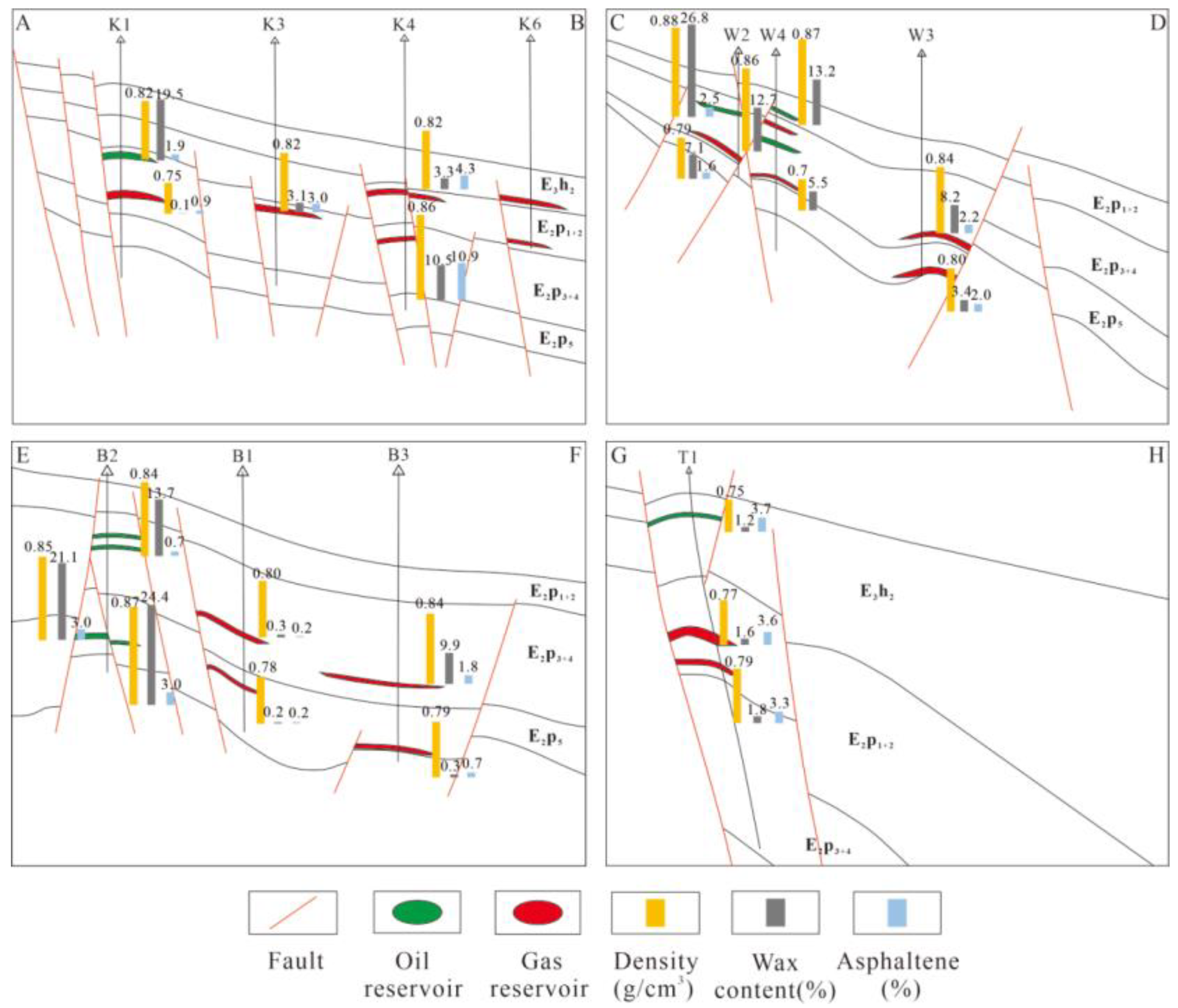

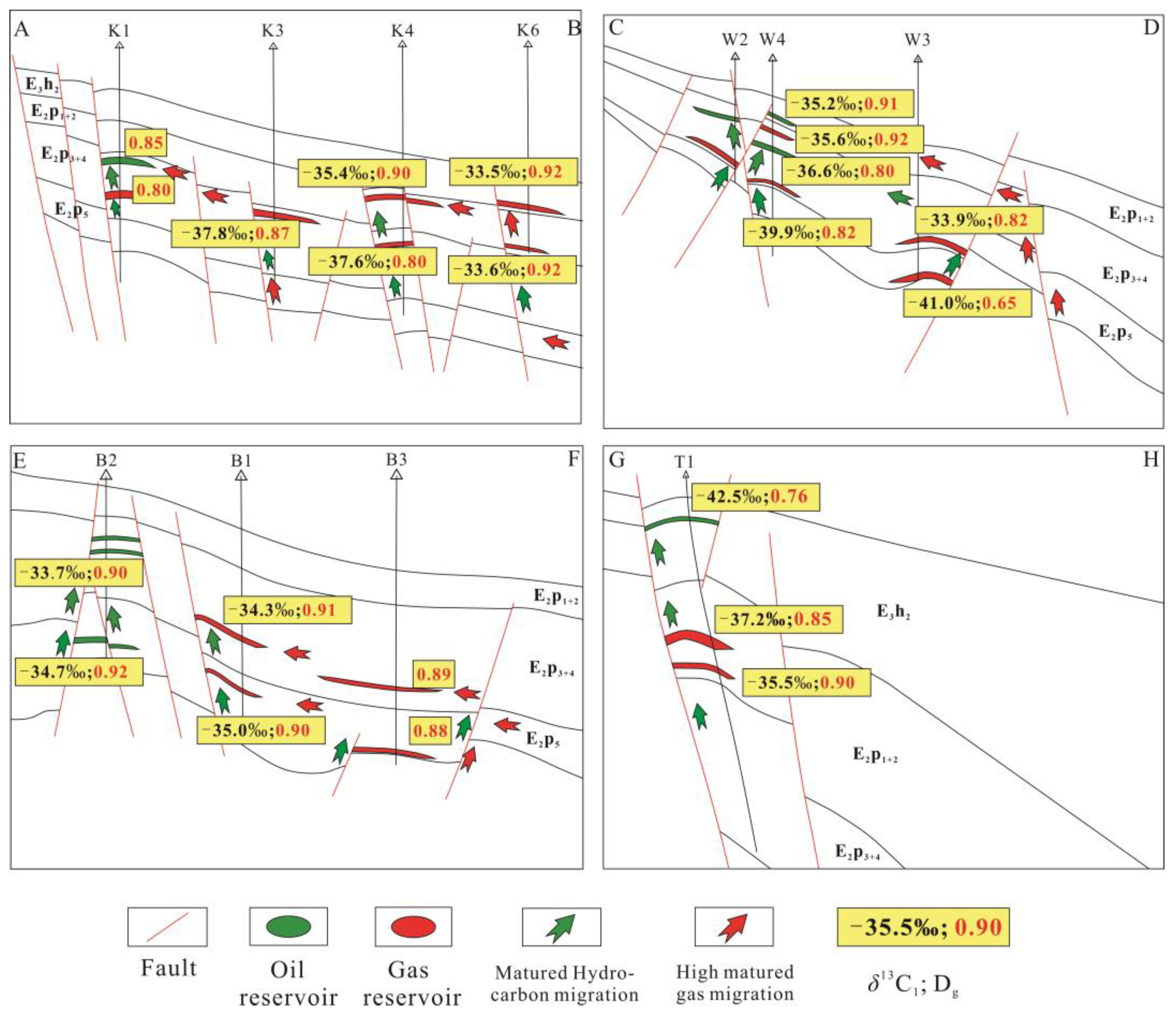
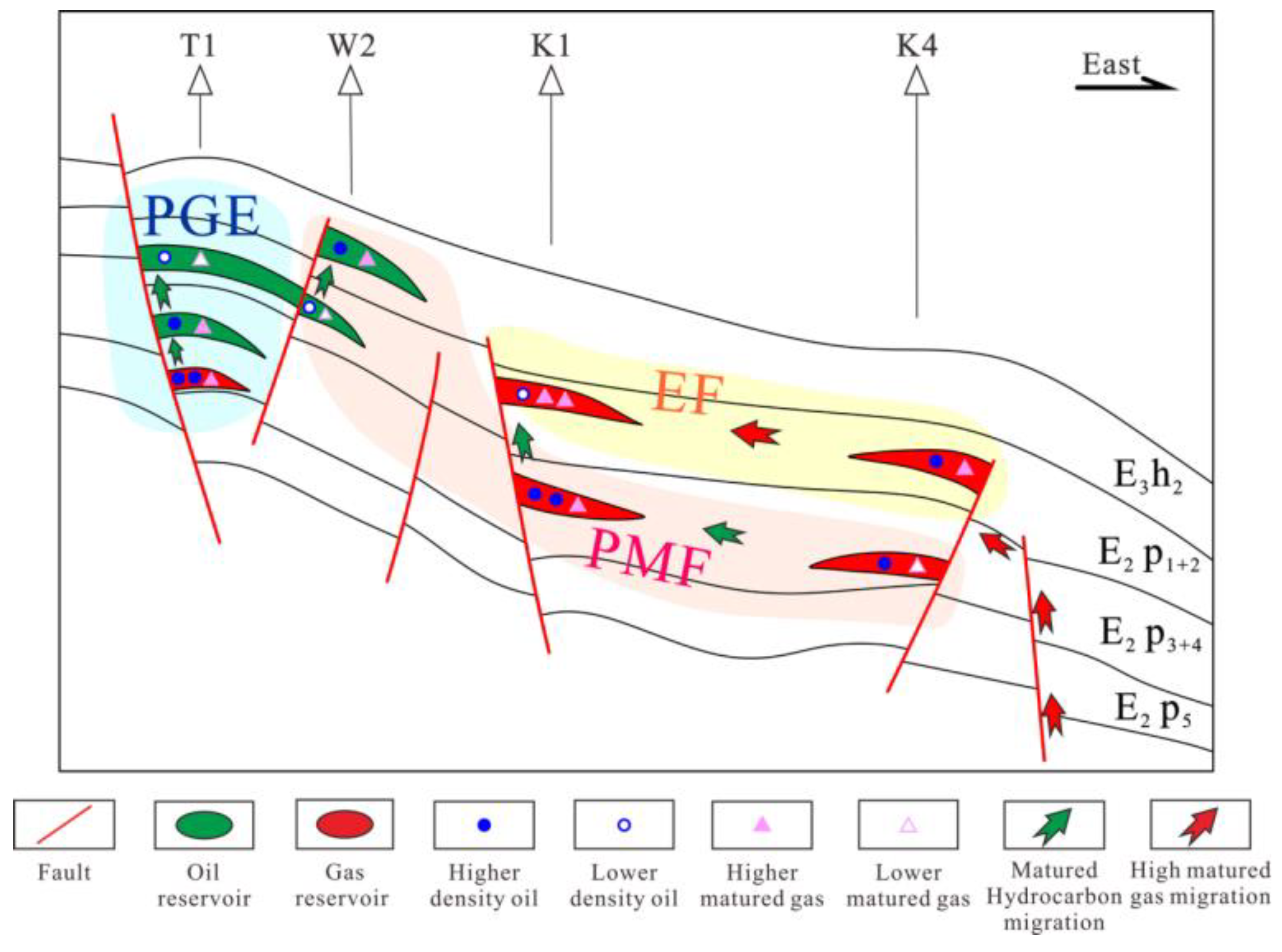
| Well | Depth/m | Formation | Density/g·cm−3 | Wax/% | Asphaltene/% |
|---|---|---|---|---|---|
| K1 | 3546 | E2p | 0.83 | 17.91 | 2.15 |
| 3567 | E2p | 0.82 | 19.53 | 1.93 | |
| 3815 | E2p | 0.75 | 0.07 | 0.88 | |
| K2 | 4160 | E2p | 0.84 | 2.11 | 4.87 |
| K3 | 4116 | E2p | 0.82 | 3.14 | 3.01 |
| 4195 | E2p | 0.82 | 3.08 | 2.84 | |
| K4 | 4190 | E2p | 0.82 | 3.27 | 4.34 |
| 4557 | E2p | 0.86 | 10.54 | 10.96 | |
| K5 | 4321 | E2p | 0.84 | 9.50 | / |
| W1 | 3503 | E2p | 0.80 | 3.36 | 0.73 |
| 3708 | E2p | 0.90 | 25.92 | 6.91 | |
| W2 | 3599 | E2p | 0.88 | 26.81 | 2.53 |
| 3804 | E2p | 0.79 | 7.05 | 1.59 | |
| W3 | 4371 | E2p | 0.84 | 8.18 | 2.19 |
| 4600 | E2p | 0.80 | 3.36 | 2.01 | |
| W4 | 3475 | E2p | 0.80 | 1.20 | / |
| 3532 | E2p | 0.87 | 13.20 | / | |
| 3614 | E2p | 0.86 | 13.70 | / | |
| 3641 | E2p | 0.86 | 17.50 | / | |
| 3744 | E2p | 0.86 | 12.70 | / | |
| B1 | 3774 | E2p | 0.80 | 0.29 | 0.23 |
| 3955 | E2p | 0.78 | 0.26 | 0.17 | |
| B2 | 3398 | E2p | 0.84 | 13.71 | 0.76 |
| 3453 | E2p | 0.85 | 21.05 | 3.04 | |
| 3773 | E2p | 0.87 | 24.45 | 3.01 | |
| B3 | 3955 | E2p | 0.84 | 9.87 | 1.83 |
| 4184 | E2p | 0.79 | 0.26 | 0.69 | |
| B4 | 4046 | E2p | 0.87 | 15.41 | 14.19 |
| T1 | 2848 | E3h | 0.75 | 1.19 | 3.72 |
| 3233 | E2p | 0.77 | 1.62 | 3.58 | |
| 3314 | E2p | 0.79 | 1.78 | 3.30 | |
| T2 | 3510 | E2p | 0.79 | 1.54 | 1.99 |
| 3780 | E2p | 0.85 | 3.13 | 6.32 |
| Well | Depth/m | Formation | 2,4-DMC5 | CyC6 | 2-MC6 | 2,3-DMC5 | 1,1-DMCyC5 | 3-MC6 | 1c3-DMCyC5 | 1t3-DMCyC5 | 1t2-DMCyC5 | nC7 | MCyC6 |
|---|---|---|---|---|---|---|---|---|---|---|---|---|---|
| K2 | 4160 | E2p | 35.56 | 1028.47 | 418.28 | 109.46 | 148.89 | 404.51 | 223.67 | 249.03 | 346.93 | 1105.80 | 3211.35 |
| K3 | 4116 | E2p | 116.21 | 1589.61 | 620.82 | 222.73 | 170.10 | 599.37 | 339.13 | 364.40 | 534.74 | 1550.84 | 5049.73 |
| 4195 | E2p | 121.93 | 1678.18 | 657.90 | 223.54 | 169.41 | 631.97 | 363.03 | 387.77 | 561.24 | 1670.36 | 5471.05 | |
| K4 | 4190 | E2p | 117.91 | 1828.02 | 631.92 | 219.28 | 175.34 | 605.21 | 333.04 | 359.76 | 525.77 | 1581.56 | 5616.26 |
| 4557 | E2p | 35.12 | 561.06 | 201.02 | 87.97 | 51.30 | 199.93 | 137.81 | 149.62 | 226.61 | 573.25 | 2504.34 | |
| K5 | 4321 | E2p | 0.32 | 4.11 | 1.70 | 0.59 | 0.45 | 1.62 | 1.01 | 1.05 | 1.50 | 4.12 | 13.86 |
| W3 | 4371 | E2p | 109.91 | 2158.80 | 587.14 | 0.00 | 0.00 | 551.96 | 349.81 | 372.08 | 542.55 | 1439.13 | 5877.17 |
| 4600 | E2p | 178.78 | 2505.28 | 813.37 | 278.84 | 214.58 | 767.98 | 543.50 | 568.46 | 802.50 | 2024.73 | 7139.38 | |
| W4 | 3475 | E2p | 29.84 | 487.38 | 166.50 | 55.77 | 40.82 | 154.75 | 108.93 | 111.18 | 162.22 | 402.86 | 1327.33 |
| 3532 | E2p | 36.59 | 649.03 | 206.69 | 65.68 | 51.77 | 191.36 | 115.89 | 121.31 | 176.68 | 550.27 | 1895.44 | |
| 3537 | E2p | 9.13 | 211.90 | 51.95 | 17.63 | 15.46 | 49.79 | 34.13 | 35.68 | 53.00 | 142.67 | 614.86 | |
| 3546 | E2p | 4.97 | 69.95 | 27.36 | 9.27 | 5.73 | 26.31 | 14.25 | 15.00 | 22.05 | 73.48 | 236.11 | |
| 3614 | E2p | 11.63 | 231.63 | 67.65 | 23.92 | 19.38 | 65.38 | 41.34 | 42.72 | 64.31 | 183.48 | 721.69 | |
| 3641 | E2p | 11.51 | 222.97 | 65.19 | 22.83 | 18.87 | 62.46 | 42.45 | 43.96 | 65.34 | 164.53 | 676.51 | |
| 3744 | E2p | 14.07 | 283.00 | 78.14 | 27.46 | 22.25 | 74.03 | 47.59 | 49.47 | 73.81 | 205.84 | 837.36 | |
| 3760 | E2p | 25.99 | 499.34 | 150.27 | 46.65 | 41.82 | 141.22 | 88.09 | 92.09 | 132.62 | 371.14 | 1391.28 | |
| 3780 | E2p | 3.46 | 70.62 | 18.20 | 4.82 | 5.99 | 19.36 | 12.40 | 12.93 | 18.95 | 51.05 | 203.38 | |
| B1 | 3955 | E2p | 34.67 | 448.77 | 171.46 | 53.24 | 35.23 | 164.29 | 92.14 | 82.23 | 125.74 | 475.95 | 1115.25 |
| T1 | 2848 | E3h | 300.94 | 1402.21 | 1359.72 | 555.23 | 281.40 | 1310.06 | 701.08 | 743.50 | 1069.33 | 3216.77 | 7852.81 |
| 3233 | E2p | 199.42 | 2761.37 | 990.06 | 379.58 | 256.45 | 955.09 | 621.40 | 643.95 | 976.51 | 2386.20 | 8303.01 | |
| 3314 | E2p | 121.82 | 1898.12 | 674.21 | 268.18 | 185.94 | 671.66 | 451.28 | 472.54 | 726.00 | 1735.98 | 6532.02 | |
| T2 | 3510 | E2p | 163.48 | 2566.04 | 783.26 | 301.71 | 222.89 | 754.33 | 509.17 | 525.55 | 787.88 | 1841.72 | 6567.28 |
| 3780 | E2p | 168.97 | 2696.90 | 847.29 | 315.54 | 235.25 | 813.17 | 550.81 | 568.35 | 848.35 | 2018.88 | 7144.51 |
| Well | Depth/m | Formation | C1/% | C2/% | C3/% | iC4/% | nC4/% | iC5/% | nC5/% | N2/% | CO2/% | Dg |
|---|---|---|---|---|---|---|---|---|---|---|---|---|
| K1 | 3567 | E2p | 79.03 | 8.68 | 3.54 | 0.96 | 0.58 | 0.23 | 0.07 | 4.19 | 2.72 | 0.85 |
| 3815 | E2p | 75.96 | 10.33 | 5.70 | 1.80 | 0.70 | 0.25 | 0.12 | 1.70 | 3.40 | 0.80 | |
| K2 * | 4160 | E2p | 89.10 | 4.48 | 0.63 | 0.16 | 0.10 | 0.05 | 0.03 | 0.36 | 5.00 | 0.94 |
| K3 * | 4116 | E2p | 81.02 | 7.35 | 3.03 | 0.74 | 0.64 | 0.22 | 0.16 | 0.45 | 6.19 | 0.87 |
| 4195 | E2p | 81.42 | 7.29 | 2.97 | 0.72 | 0.62 | 0.22 | 0.16 | 0.18 | 6.19 | 0.87 | |
| K4 | 4190 | E2p | 85.51 | 6.28 | 2.30 | 0.59 | 0.51 | 0.18 | 0.13 | 0.20 | 4.11 | 0.90 |
| 4557 | E2p | 73.20 | 8.43 | 5.83 | 1.68 | 1.40 | 0.49 | 0.31 | 0.57 | 7.79 | 0.80 | |
| K6 * | 4238 | E3h | 89.82 | 5.51 | 1.66 | 0.44 | 0.33 | 0.14 | 0.09 | 0.00 | 1.99 | 0.92 |
| 4818 | E2p | 91.61 | 5.33 | 1.50 | 0.36 | 0.36 | 0.18 | 0.14 | 0.45 | 0.01 | 0.92 | |
| K7 | 4121 | E2p | 79.43 | 8.38 | 2.84 | 1.04 | 0.65 | 0.28 | 0.20 | 0.59 | 6.29 | 0.86 |
| W1 * | 3503 | E2p | 86.70 | 7.19 | 3.08 | 0.61 | 0.53 | 0.13 | 0.06 | 0.41 | 1.29 | 0.88 |
| W2 * | 3599 | E2p | 84.89 | 7.80 | 3.17 | 0.74 | 0.79 | 0.38 | 0.22 | 0.22 | 1.79 | 0.87 |
| 3834 | E2p | 80.82 | 9.84 | 4.79 | 1.01 | 0.97 | 0.32 | 0.21 | 0.34 | 1.70 | 0.83 | |
| W3 | 4371 | E2p | 77.24 | 10.11 | 4.37 | 1.00 | 1.00 | 0.37 | 0.25 | 1.28 | 4.38 | 0.82 |
| 4600 | E2p | 59.47 | 14.97 | 10.95 | 2.81 | 2.60 | 0.82 | 0.52 | 7.87 | 0.00 | 0.65 | |
| W4 * | 3532 | E2p | 87.88 | 5.76 | 2.02 | 0.37 | 0.29 | 0.07 | 0.04 | 0.61 | 2.94 | 0.91 |
| 3537 | E2p | 88.22 | 5.76 | 1.89 | 0.33 | 0.26 | 0.07 | 0.04 | 0.00 | 3.43 | 0.91 | |
| 3614 | E2p | 89.56 | 5.18 | 1.80 | 0.37 | 0.28 | 0.08 | 0.04 | 0.81 | 1.84 | 0.92 | |
| 3641 | E2p | 87.73 | 6.28 | 2.41 | 0.53 | 0.38 | 0.12 | 0.06 | 0.57 | 1.92 | 0.90 | |
| 3740 | E2p | 76.73 | 10.98 | 5.71 | 1.21 | 1.06 | 0.30 | 0.18 | 0.20 | 3.60 | 0.80 | |
| 3744 | E2p | 83.44 | 6.70 | 2.30 | 0.40 | 0.27 | 0.06 | 0.03 | 4.16 | 2.64 | 0.90 | |
| 3760 | E2p | 84.18 | 7.53 | 2.88 | 0.59 | 0.53 | 0.16 | 0.10 | 0.90 | 3.12 | 0.88 | |
| 3780 | E2p | 77.37 | 10.35 | 4.72 | 0.94 | 0.79 | 0.01 | 0.13 | 1.66 | 4.02 | 0.82 | |
| 4050 | E2p | 76.30 | 9.74 | 6.14 | 1.83 | 1.27 | 0.44 | 0.24 | 0.48 | 3.53 | 0.80 | |
| 4056 | E2p | 79.05 | 8.97 | 5.17 | 1.58 | 1.12 | 0.50 | 0.28 | 0.00 | 3.29 | 0.82 | |
| B1 | 3774 | E2p | 88.16 | 4.84 | 2.51 | 0.60 | 0.50 | 0.16 | 0.11 | 0.60 | 2.52 | 0.91 |
| 3955 | E2p | 86.47 | 5.58 | 3.02 | 0.62 | 0.56 | 0.13 | 0.10 | 1.56 | 1.96 | 0.90 | |
| B2 | 3455 | E2p | 89.21 | 5.98 | 2.67 | 0.88 | 0.39 | 0.22 | 0.08 | 0.49 | 0.08 | 0.90 |
| 3773 | E2p | 88.59 | 5.43 | 1.62 | 0.34 | 0.26 | 0.11 | 0.04 | 2.00 | 1.61 | 0.92 | |
| B3 * | 3955 | E2p | 86.82 | 5.42 | 3.18 | 0.80 | 0.67 | 0.17 | 0.09 | 0.44 | 2.41 | 0.89 |
| 4184 | E2p | 86.92 | 6.94 | 3.16 | 0.60 | 0.70 | 0.00 | 0.00 | 0.67 | 1.01 | 0.88 | |
| T1 * | 2848 | E3h | 73.08 | 7.06 | 5.89 | 4.36 | 2.83 | 1.77 | 0.89 | 1.89 | 1.55 | 0.76 |
| 3233 | E2p | 81.80 | 6.97 | 4.46 | 1.44 | 1.04 | 0.36 | 0.19 | 1.31 | 2.26 | 0.85 | |
| 3314 | E2p | 87.58 | 5.22 | 2.51 | 0.75 | 0.53 | 0.21 | 0.10 | 0.85 | 2.03 | 0.90 | |
| T2 | 3510 | E2p | 87.51 | 5.07 | 2.40 | 0.63 | 0.47 | 0.17 | 0.10 | 0.54 | 2.94 | 0.91 |
| 3780 | E2p | 87.06 | 5.57 | 4.02 | 1.31 | 0.77 | 0.32 | 0.16 | 0.45 | 0.00 | 0.88 |
| Well | Depth/m | Formation | δ13C1 | δ13C2 | δ13C3 | δ13iC4 | δ13nC4 | δ13CO2 | Rog/% |
|---|---|---|---|---|---|---|---|---|---|
| K2 * | 4160 | E2p | −37.1 | −22.7 | −20.8 | −19.8 | −21.7 | / | 0.9 |
| K3 * | 4116 | E2p | −37.8 | −27.2 | −25.4 | −26.1 | −24.6 | / | 0.8 |
| K4 | 4190 | E2p | −35.4 | −25.7 | −24.4 | −25.4 | −24.8 | / | 0.9 |
| 4557 | E2p | −37.6 | −27.5 | −26.1 | −27.4 | −25.9 | / | 0.8 | |
| K6 * | 4238 | E3h | −33.5 | −26.3 | −24.0 | −23.7 | −23.0 | −5.2 | 1.0 |
| 4818 | E2p | −33.6 | −28.4 | −27.1 | −22.7 | −22.7 | −5.6 | 1.0 | |
| K7 | 4121 | E2p | −34.6 | −25.3 | −24.5 | −26.8 | −25.4 | −10.6 | 1.0 |
| W3 | 4371 | E2p | −33.9 | −25.3 | −24.2 | −25.8 | −24.8 | −5.9 | 1.0 |
| 4600 | E2p | −41.0 | −28.6 | −26.1 | / | / | −4.8 | 0.7 | |
| W4 * | 3532 | E2p | −35.2 | −26.7 | −24.5 | −25.1 | −23.7 | −6.6 | 1.0 |
| 3537 | E2p | −35.4 | −26.9 | −24.7 | −25.3 | −24.2 | −7.1 | 0.9 | |
| 3614 | E2p | −35.6 | −26.7 | −24.6 | −25.4 | −23.8 | −8.8 | 0.9 | |
| 3641 | E2p | −36.2 | −26.0 | −23.7 | −24.8 | −23.0 | −9.4 | 0.9 | |
| 3740 | E2p | −36.6 | −28.5 | −25.9 | −27.0 | −24.7 | −9.8 | 0.9 | |
| 3744 | E2p | −37.1 | −26.3 | −23.7 | −24.8 | −23.0 | −7.3 | 0.9 | |
| 3760 | E2p | −36.4 | −25.9 | −23.3 | −24.3 | −22.6 | −9.4 | 0.9 | |
| 3780 | E2p | −37.1 | / | / | / | / | / | 0.9 | |
| 4050 | E2p | −39.9 | −29.5 | −27.3 | −28.7 | −26.2 | −10.6 | 0.8 | |
| 4056 | E2p | −39.9 | −29.5 | −27.4 | −28.9 | −26.1 | −10.6 | 0.8 | |
| B1 | 3774 | E2p | −34.3 | −27.4 | −27.4 | / | −27.1 | −18.9 | 1.0 |
| 3955 | E2p | −35.0 | −30.9 | −27.8 | / | −26.3 | −19.8 | 1.0 | |
| B2 | 3455 | E2p | −33.7 | −26.7 | −22.1 | / | −30.1 | −15.6 | 1.0 |
| 3773 | E2p | −34.7 | −27.1 | −25.7 | / | −24.9 | −17.3 | 1.0 | |
| T1 * | 2848 | E3h | −42.5 | −27.4 | −25.8 | −26.9 | −25.3 | −6.7 | 0.7 |
| 3233 | E2p | −37.2 | −27.4 | −26.2 | −27.5 | −25.3 | −7.0 | 0.9 | |
| 3314 | E2p | −35.5 | −27.3 | −26.2 | −27.3 | −25.2 | −7.7 | 0.9 | |
| T2 | 3510 | E2p | −36.0 | −27.4 | −26.3 | −27.6 | −25.7 | / | 0.9 |
| 3780 | E2p | −36.2 | −27.5 | −26.2 | −27.4 | −25.4 | / | 0.9 |
| Well | Depth/m | Formation | K1 | T/°C | RoK/% | MPI1 | RoP/% |
|---|---|---|---|---|---|---|---|
| K2 | 4160 | E2p | 1.20 | 123.14 | 0.8 | 0.84 | 0.9 |
| K3 | 4116 | E2p | 1.18 | 130.24 | 0.9 | 1.02 | 1.0 |
| 4195 | E2p | 1.17 | 130.91 | 0.9 | 1.01 | 1.0 | |
| K4 | 4190 | E2p | 1.18 | 130.69 | 0.9 | 0.97 | 1.0 |
| 4557 | E2p | 1.23 | 126.22 | 0.9 | 0.71 | 0.8 | |
| K5 | 4321 | E2p | 1.18 | 130.97 | 0.9 | 1.04 | 1.0 |
| W3 | 4371 | E2p | 1.19 | 131.08 | 0.9 | 1.15 | 1.1 |
| 4600 | E2p | 1.17 | 132.39 | 1.0 | 1.00 | 1.0 | |
| W4 | 3475 | E2p | 1.20 | 130.62 | 0.9 | 0.98 | 1.0 |
| 3532 | E2p | 1.19 | 131.22 | 0.9 | 1.09 | 1.1 | |
| 3537 | E2p | 1.18 | 130.13 | 0.9 | 1.09 | 1.1 | |
| 3546 | E2p | 1.17 | 130.66 | 0.9 | 1.03 | 1.0 | |
| 3614 | E2p | 1.19 | 129.18 | 0.9 | 1.10 | 1.1 | |
| 3641 | E2p | 1.19 | 129.72 | 0.9 | 0.97 | 1.0 | |
| 3744 | E2p | 1.20 | 129.97 | 0.9 | 1.03 | 1.0 | |
| 3760 | E2p | 1.18 | 131.22 | 0.9 | 1.09 | 1.1 | |
| 3780 | E2p | 1.01 | 135.03 | 1.0 | 1.25 | 1.1 | |
| B1 | 3955 | E2p | 1.13 | 133.57 | 1.0 | 1.02 | 1.0 |
| T1 | 2848 | E3h | 1.19 | 130.81 | 0.9 | 0.74 | 0.8 |
| 3233 | E2p | 1.19 | 130.34 | 0.9 | 0.82 | 0.9 | |
| 3314 | E2p | 1.19 | 128.16 | 0.9 | 0.66 | 0.8 | |
| T2 | 3510 | E2p | 1.18 | 130.81 | 0.9 | 1.26 | 1.2 |
| 3780 | E2p | 1.18 | 130.63 | 0.9 | 1.00 | 1.0 |
| Well | Depth/m | Formation | δ13C/‰, PDB | ||||
|---|---|---|---|---|---|---|---|
| Oil | Sat | Aro | Nso | Asp | |||
| K2 | 4160 | E2p | −24.8 | −25.4 | −24.3 | / | / |
| K5 | 4321 | E2p | −26.9 | −27.2 | −25.6 | −26.7 | −27.3 |
| W3 | 4371 | E2p | −25.9 | −27.3 | −24.5 | / | / |
| 4600 | E2p | −26.2 | −27.7 | −24.8 | / | / | |
| W4 | 3475 | E2p | −27.3 | −27.5 | −27.4 | −28.9 | −28.3 |
| 3532 | E2p | −27.3 | −27.4 | −28.0 | −29.7 | −28.1 | |
| 3537 | E2p | −27.2 | −28.0 | −25.6 | −26.4 | −27.5 | |
| 3546 | E2p | −27.0 | −27.1 | −26.4 | −27.7 | −27.5 | |
| 3614 | E2p | −26.6 | −27.6 | −25.4 | −26.1 | −27.0 | |
| 3641 | E2p | −26.8 | −27.3 | −25.2 | −26.0 | −26.9 | |
| 3744 | E2p | −26.9 | −27.4 | −25.8 | −26.2 | −27.3 | |
| 3760 | E2p | −27.2 | −27.2 | −26.8 | −29.0 | −28.0 | |
| 3780 | E2p | −26.9 | −27.2 | −26.5 | −27.9 | −28.1 | |
| B1 | 3955 | E2p | / | −27.8 | −25.2 | −26.5 | −26.2 |
| 3774 | E2p | / | −27.4 | −24.1 | −26.8 | −27.0 | |
| B2 | 3398 | E2p | / | −28.6 | −27.1 | / | / |
| 3453 | E2p | / | −27.4 | −28.3 | −27.1 | / | |
| 3773 | E2p | / | −29.2 | −26.1 | / | / | |
| T1 | 2848 | E3h | −26.3 | −26.6 | −25.1 | / | / |
| 3233 | E2p | −26.2 | −26.9 | −24.9 | / | / | |
| 3314 | E2p | −26.1 | −26.7 | −24.9 | / | / | |
| T2 | 3510 | E2p | −26.4 | −28.0 | −25.6 | / | / |
| 3780 | E2p | −26.9 | −28.1 | −25.6 | / | / | |
| Mechanism | Direction of Migration | Evaluation Parameter with the Direction of Migration | Type of Reservoir | Block Represented | |
|---|---|---|---|---|---|
| Density & Wax | Rog & δ13C1 | ||||
| Produced-exhausted and geochromatographic effects (PGE) | Deep to shallow, vertical | Reduced | Reduced | Primary | T1, B2 |
| Evaporative fractionation (EF) | Deep to shallow, transversal | Reduced | Increased | Modified | K4 |
| Phase-controlled migration fractionation (PME) | All of the above | Increased | Increased | Modified | K1, W2 |
Disclaimer/Publisher’s Note: The statements, opinions and data contained in all publications are solely those of the individual author(s) and contributor(s) and not of MDPI and/or the editor(s). MDPI and/or the editor(s) disclaim responsibility for any injury to people or property resulting from any ideas, methods, instructions or products referred to in the content. |
© 2023 by the authors. Licensee MDPI, Basel, Switzerland. This article is an open access article distributed under the terms and conditions of the Creative Commons Attribution (CC BY) license (https://creativecommons.org/licenses/by/4.0/).
Share and Cite
Li, W.; Chen, J.; Liu, K.; Fu, R.; Chen, C.; Wang, Y.; Zhu, X.; Chen, X.; Zhang, T.; He, L. Studies on the Source and Phase Characteristics of Oil and Gas: Evidence from Hydrocarbon Geochemistry in the Pingbei Area of Xihu Sag, the East China Sea Shelf Basin, China. Energies 2023, 16, 6529. https://doi.org/10.3390/en16186529
Li W, Chen J, Liu K, Fu R, Chen C, Wang Y, Zhu X, Chen X, Zhang T, He L. Studies on the Source and Phase Characteristics of Oil and Gas: Evidence from Hydrocarbon Geochemistry in the Pingbei Area of Xihu Sag, the East China Sea Shelf Basin, China. Energies. 2023; 16(18):6529. https://doi.org/10.3390/en16186529
Chicago/Turabian StyleLi, Wei, Jianfa Chen, Kaixuan Liu, Rao Fu, Cong Chen, Yingxun Wang, Xinjian Zhu, Xiaodong Chen, Tonglei Zhang, and Liwen He. 2023. "Studies on the Source and Phase Characteristics of Oil and Gas: Evidence from Hydrocarbon Geochemistry in the Pingbei Area of Xihu Sag, the East China Sea Shelf Basin, China" Energies 16, no. 18: 6529. https://doi.org/10.3390/en16186529
APA StyleLi, W., Chen, J., Liu, K., Fu, R., Chen, C., Wang, Y., Zhu, X., Chen, X., Zhang, T., & He, L. (2023). Studies on the Source and Phase Characteristics of Oil and Gas: Evidence from Hydrocarbon Geochemistry in the Pingbei Area of Xihu Sag, the East China Sea Shelf Basin, China. Energies, 16(18), 6529. https://doi.org/10.3390/en16186529






